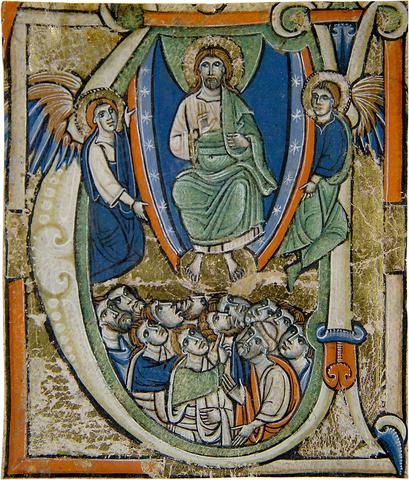
Ascension
Venise
1250 (vers)
Tempera et feuille d’or sur vélin ; 9,1 x 7,7 cm
Provenance :
Londres, Christie’s, 23 novembre 2011.
Cette initiale historiée V, découpée dans un livre de chœur, un antiphonaire ou un graduel, introduit la messe de l’Ascension et pourrait correspondre à l’une ou l’autre antienne : « Viri Galilaei, quid aspicitis in coelum ? Hic Jesus qui assumptus est a vobis in coelum, sic veniet… », « Videntibus illis elevatus est, et nubes suscepit eum in coelo…»
D’une grande qualité d’exécution, cette œuvre présente des affinités stylistiques étroites avec les productions de l’école vénéto-padouane du milieu du 13ème siècle, et peut être rapprochée en particulier d’un antiphonaire de San Marco exécuté vers la fin du deuxième quart du 13ème siècle, ainsi que de l’épistolier de Johannes de Gaibana, décoré par le Maître de Gaibana en 1259 (Padoue, Biblioteca Capitolare), et des œuvres qui lui sont apparentées, telles le Psautier d’Oxford (Bodleian Library).
Imprégnées d’une forte influence byzantine, ces œuvres offrent la plupart des ingrédients de l’enluminure vénéto-padouane, avec leurs figures aux visages striés d’ombres et de lumières, leurs draperies structurées, leurs tuniques aux encolures évasées, leurs initiales enchâssées dans d’épais encadrements colorés, leurs couleurs éclatantes où la couleur rouge domine, le bleu, le vert et leur ornementation de feuillages aux lobes rehaussés de multiples traits blancs, d’inspiration septentrionale, autant de traits que l’on retrouve dans l’initiale de l’Ascension.
Des parallèles peuvent également être établis avec les mosaïques de l’atrium de Saint-Marc de Venise réalisées dans la seconde moitié du 13ème siècle, en particulier au niveau du traitement des draperies et des visages – l’apparition du Seigneur à Babel, représentée sur la voûte nord de la baie située à l’entrée de l’atrium, offre à cet égard d’étroites ressemblances avec le Christ en majesté de l’initiale, de même qu’avec l’enluminure du premier style bolonais qui s’est développé à partir du milieu du 13ème siècle et qui partage des caractéristiques communes avec l’enluminure vénéto-padouane.
Ces quelques jalons suggèrent que cette initiale a pu être exécutée dans la région de Venise vers la fin du second quart du 13ème siècle, probablement après l’antiphonaire de San Marco, l’un des premiers témoins attestés de la manière grecque, et avant l’Épistolier de Gaibana, qui en est, quant à lui, l’une des manifestations les plus abouties. Elle vient enrichir notre connaissance de l’enluminure du Nord-Est de l’Italie vers le milieu du 13ème siècle, à une époque où les artistes cherchaient à se dégager de la manière romane pour construire un langage nouveau à partir d’influences diverses issues aussi bien de l’Est que de régions septentrionales.
